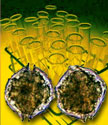|
|
|
|
|
 |
 |
Although their impact is large,
the causative "critters" are tiny. The longest dimension
of these dinoflagellates and diatoms is 30-140 microns (human hair
is about 80 microns wide); "Brown Tide"
cells are at least ten times smaller! Typical dinoflagellates use
two whip-like flagella to swim. Diatoms hold plant matter within
glass shells, cannot swim, and often have spines that help them
float. Like other organisms, plankton thrive in specific environments;
thus scientists study which conditions favor Harmful Algal Bloom
formation. NOTE that not all species which
cause these illnesses are shown.
|
|
|
|
|
|
|
|
|
|
|
 |
|
 |
 |
 |
|
|
|
TOXIC DINOFLAGELLATE BLOOMS
|
|
|
|
|
|
- Toxic dinoflagellate
lives on the red and brown seaweed associated with coral reefs
- Optimal growth conditions: Shallow waters, 20-34°C,
salinity of 25-40 PSU
- CFP is one of the most reported food-borne illnesses
|
|
|
|
- Although these DSP-producing algae have been
found along the U.S. coast, there
have been no reports of DSP-related illness
- The U.S. Food and Drug Administration (FDA)
limit of DSP toxins in shellfish is 0.2 parts okadaic acid per million
|
|
|
|
- Optimal growth time: Late fall; Eastern Gulf
of Mexico circulation determines bloom distribution
- Researchers are working to discover the temperature,
salinity & nutrient conditions that favor Karenia brevis's
growth
- The FDA limit of NSP toxins in shellfish is
0.8 parts brevetoxin per million
|
|
|
 |
|
- Unlike most dinoflagellates, Alexandrium
catenella forms chains; its cells swim
together in a snake-like fashion
- Found along U.S. west coast
- Highest toxicity in July and August; outbreaks occur when coastal
upwelling decreases in intensity
|
|
|
- A. tamarense and A. fundyense occur along
U.S. northeast coast
- Toxicity of cells increases from south to north;
toxicity appears to be influenced by ratio of nitrogen to phosphorus in seawater; Gulf of Maine circulation
and cyst distributions influence blooms
- The FDA limit of PSP toxins in shellfish is
0.8 parts saxitoxin per million; amounts
as low as 1.25 and 4.5 ppm have been shown to cause illness and
death, respectively
|
|
|
|
|
|
|
|
|
 |
 |
- P. multiseries
was first identified as toxic in 1987 when 150 people became ill
-- and three died -- after eating blue mussels on Prince Edward
Island (Canada)
- Optimal growth conditions: warm surface waters
that are layered by temperature.
- The FDA limit of ASP toxins in shellfish is 20 parts domoic
acid per million
|
|
|
|
|
|
|
HARMFUL
BLOOMS (non-toxic or toxicity under investigation*)
|
|
|
 |
 |
- *Although no toxin has been isolated for P.
piscicida; this dinoflagellate appears to be harmful only
in the presence of fish
- P. piscicida has amoeboid, encysted and flagellated (shown at left) stages; growth
stage is influenced by nutrients
- Optimal growth conditions: Poorly flushed
upper estuarine tributaries, 26°C or warmer, salinity
of 15 PSU
- The raphidophyte H. akashiwo is a golden-colored
algae with two flagella and numerous disk-shaped chloroplasts
- Washington: Found in waters warmer than 15°C
- Rhode Island: Tied to large-scale atmospheric
patterns (i.e., the North Atlantic Oscillation) with seasonal
pulses in late spring/early summer and mid-late fall
- Although all species of Chaetoceros use
"glass-like" siliceous spines to float, C. convolutus's
numerous needle-like spines are particularly irritating to gills
and contribute to massive fish kills
|
 |
 |
|
|
|
|
|
 |
- Mid-Atlantic Brown Tides
are caused by very small (2-3 micrometers) plankton,
Aureococcus anophagefferens
- At left, Aureococcus are the bright
"blobs" (seen under blue excitation); this sample
has over 300,000 Aureococcus cells per milliliter
- Aureococcus produces a substance
called "mucopolysaccharide" that clogs gills of
filter feeders, causing them to stop feeding and ultimately
starve to death.
- Brown tides caused the collapse of the scallop
fishery in Long Island bays.
- Optimal growth conditions: Poorly flushed
estuaries, late spring/early summer, 20-25°C, salinity
of 28 PSU or higher; can flourish in low light; thrive in
high concentrations of organic nitrogen.
- Texas Brown Tides
are caused by slightly larger (4-5 micrometers)
nanoplankton, Aureoumbra lagunensis
- Optimal growth conditions: Shallow embayments;
especially lagoons with miminal water transport and relatively
high salinity
|
 |
|
|
|
|
|
 |
 |
|



















